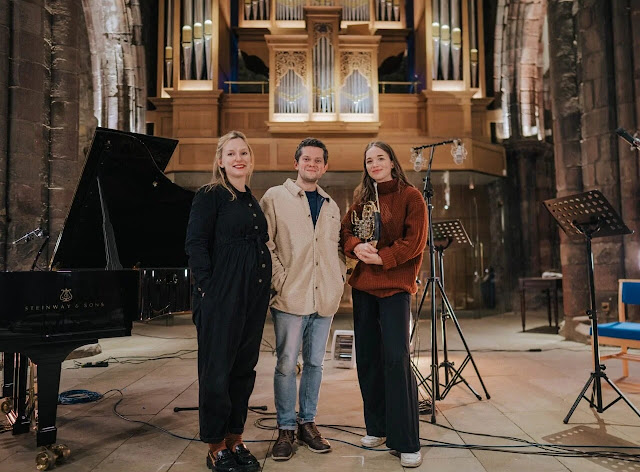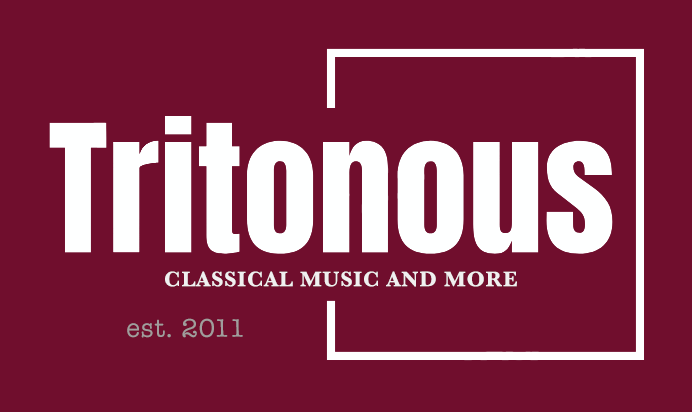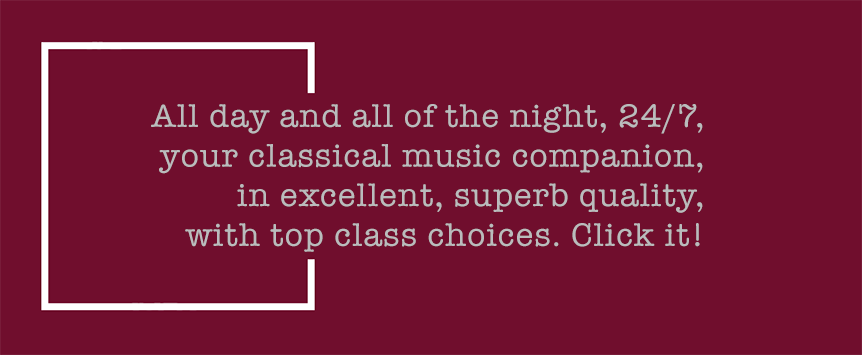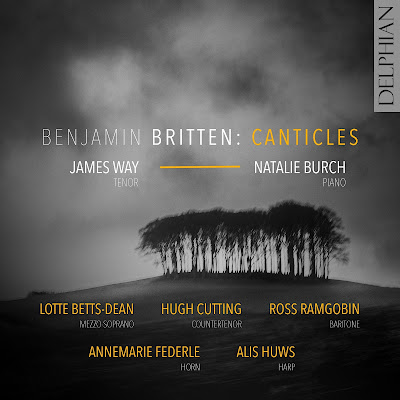 |
| Natalie Burch, James Way and Annemarie Federle at St Mary’s Parish Church, Haddington where their recording of Britten’s Canticles was made (Photo: Will Coates-Gibson/Foxbrush) |
Britten: Five Canticles; Errollyn Wallen; My Lazy Goodheart, Schubert: Auf dem Strom, Des Fischers Liebesgluck; Lotte Betts-Dean, James Way, Ross Ramgobin, Natalie Burch, Alis Huws, Annemarie Federle; Milton Court Concert Hall
Reviewed 16 April 2025
Britten’s complete canticles alongside Schubert and Errollyn Wallen in a profoundly satisfying programme that combined musicality and sympathy with a sense of young performers looking at these modern classics anew
Tenor James Way and his duo partner (and wife), pianist Natalie Burch have recorded Britten’s five Canticles for Delphian on a very tempting disc [see details] that pairs the canticles with Priaulx Rainier’s Cycle for Declamation written for Peter Pears in 1955.
On Wednesday 16 April 2025, James Way and Natalie Burch were joined by other performers from the disc, mezzo-soprano Lotte Betts-Dean, baritone Ross Ramgobin, horn player Annemarie Federle and harpist Alis Huws at the Barbican Centre‘s Milton Court concert hall for an evening the mixed Britten’s canticles with two songs by Britten’s beloved Schubert, Auf dem Strom (for voice, horn and piano) and Des Fischers Liebesglück , plus Errollyn Wallen‘s My Lazy Goodheart. The programme represented an intriguing solution to the problem of presenting Britten’s canticles in concert, pairing them with Schubert and with Ross Ramgobin (and Annemarie Federle) performing the Schubert and Lotte Betts-Dean not only performing the Errollyn Wallen but taking the alto part in Britten’s Journey of the Magi, they ensured a balance of stage time for everyone.
Britten’s canticles form an intriguing thread running through his composing career from 1947 to 1974, and as Alexandra Coghlan’s article in the programme book points out, each canticle can be linked to Britten’s concerns from his then current opera. Strictly, of course, they are not canticles at all, at least not in the Christian liturgical sense, but despite the varied nature of the pieces there is a commonality running through them, perhaps thanks to the focus of having just voice and instruments in a work that is not strictly song with texts that take a somewhat sidelong glance at religious matters.
We began at the beginning with Canticle I, the 1947 setting of A Divine Rapture by 17th century poet Francis Quarles, an astonishing piece of homosexual outpouring disguised as religious. But the work was written by Britten for Pears (and Pears is the common thread through all the canticles), which must have given performances of the piece in the late 1940s a particular frisson. James Way sang with vibrant tone and great sympathy for the words, his vivid, lyrical outpourings complemented by the fine detail from Natalie Burch in the piano. There is a sense in this piece of the piano unfolding elegantly whilst the voice rhapsodises over the top. Despite working hard, James Way did not quite manage to project the words full, and from Row N we rather needed the surtitles. There was a sense of drama, as Way and Burch heightened Britten’s variations and contrasts in the drama.
We followed this with Lotte Betts-Dean and Natalie Burch performing Errollyn Wallen’s My Lazy Goodheart which was originally written for jazz vocalist Kate Westbrook, setting Westbrook’s own words. Betts-Dean really leaned into the song’s laid-back, jazz-influenced style bringing out the bluesy relaxed tone. This was wonderfully vividly done, it worked as a contrast to the Britten though I wondered how the one spoke to the other. One thing I did notice, as in Britten’s Canticle I, the piano in Wallen’s piece was flowing, running on with fine detail and the voice unfolding over.
Schubert was important to Britten, he and Pears were fine interpreters of Schubert’s music and if you are performing music for voice, piano and horn, then Schubert’s Auf dem Strom is surely a given. Here is was performed by Ross Ramgobin, Annemarie Federle and Natalie Burch. A late song with hints of homage to Beethoven, it is a piece of magic, large in scale yet seductive. Here, we were seduced from the outset by Annemarie Federle’s wonderfully warm tone and sophisticated yet mellow approach to phrasing. Ramgobin complemented this with a vividly sound in a highly concentrated, focused performance. His vibrant sound brought out the underlying drama leading to the mysticism in the final verse as the poet looks up at the stars, but there were moments when I wished Ramgobin less concerned with tone quality and had emphasised the words more.
We finished the first half with Britten’s Canticle III, the astonishing setting of Edith Sitwell’s Still Falls the Rain: The raids 1940. Night and dawn. Britten and Sitwell later expanded the work into the larger scale The Heart of the Matter and we were due to hear James Way performing this last year at Temple Music but illness prevented him [see my review].
In Still Falls the Rain, written in 1954 Britten creates a sequence of variations for horn and piano which link both to The Turn of the Screw ( also from 1954) and to Lachrymae (from 1950). Here the variations punctuate the tenor’s strong ariosos, the words being the focus of attention. Federle’s horn began dark, veiled and sober, with each instrumental interlude developing new and vivid character finally becoming sharp and edgy, then robust and rhythmic. From the outset, Way’s tenor was intense and vibrant, here the words were paramount and we certainly did not need the surtitles. He brought an expressive relish to the melismatic passages, but overall it was his way with the text and the strong message that made his performance so compelling. And at the end, the two, voice and horn, combined for the rather austere yet consoling final chorale. The performance was commanding and compelling in so many ways; if James Way has not sung Peter Quint in The Turn of the Screw then someone should snap him up quickly, and the idea of the Serenade for tenor, horn and strings with Way and Federle is profoundly tempting.
After the interval we moved onto Britten’s final, and most intriguing canticle, Canticle V, setting TS Eliot’s elusive early text The Death of Saint Narcissus. We began with Alis Huws’ seductive, rippling harp, joined by James Way’s tenor in rather compelling recitative. Way brought a wonderful attention to detail in the piece, capturing the changeable moods and vivid rhythms, yet imbuing it with a sense of mystery. Eliot’s text is a fascinating imaginative leap, the original St. Narcissus was an early Patriarch of Jerusalem, but in Britten’s hands the result is far more vivid and life-affirming.
Schubert’s Des Fischers Liebesglück dates from after he had completed Winterreise, it is a remarkably compact, yet philosophical poem which Schubert sets in a strophic manner which belies the underlying simplicity. Ross Ramgobin returned to the platform to perform it with Natalie Burch, giving a beautifully lyric, controlled performance with some lovingly crafted portamenti in the leaps in the melody. This was all about colour and tone quality, ultimately giving a haunting quality to the end of the song.
Britten’s fourth canticle, The Journey of the Magi sets the TS Eliot poem for alto, tenor, baritone and piano. It was premiered at the 1971 Aldeburgh Festival by James Bowman, Peter Pears and John Shirley Quirk and it has subsequently been associated with male voices. On the Delphian recording James Way and Ross Ramgobin are joined by Hugh Cutting, but here in a neat move the alto part was sung by mezzo-soprano Lotte Betts-Dean. Her very particular vocal quality and the very ardent approach of all three singers moved the work well away from the aetherial, Oxbridge style which has become associated with the work. Here we had not a blend, but three voices synthesised into something distinctive, all three bringing subtlety and vibrancy to the narrative, giving profound meaning to the words (and again, surtitles were redundant).
This sense of rediscovering the canticles continued with Canticle II, setting an excerpt from the Chester Mystery Plays as Abraham and Isaac, written in 1952 for Pears and Kathleen Ferrier (for a fundraiser for the English Opera Group). Here sung by Lotte Betts-Dean and James Way, with Natalie Burch, the sound quality at the beginning, when God is speaking, was again a distance from aetherial, this God was eerily magical in character, yet still unearthly, drawing you into the story. The two soloists interacted dynamically, quasi-dramatising and giving us a piece of vibrant story telling. The two voices contrasting but compelling in the attention to detail and the vibrant melismatic sections. The final sections, when Isaac accepts his fate, had a simplicity imbued with underlying passion, leading to a sense of expectation and anxiety. The final envoi saw the two voices contrasting yet complementary and both very present.
This was an intelligent and finely satisfying recital, the additions to the programme taking it some way from the tenor showpiece that the canticles can be, and all three singers gave the sense of reinventing and rediscovering this music, along with superb support from all three instrumentalists. If you have not already bought the disc, then I urge you to do so [further details].
The blog is free, but I’d be delighted if you were to show your appreciation by buying me a coffee.
Elsewhere on this blog
- This production, will undoubtedly be remembered for years to come: Massenet’s Werther in Paris with Marina Viotti, Benjamin Bernheim & Marc Leroy-Calatayud conducting Les Siècles – opera review
- Compelling & magisterial: Sunwook Kim directs Chamber Orchestra of Europe from the piano in Beethoven’s 3rd & 4th piano concertos – review
- Letter from Florida: Mozart, Verdi, Rossini, Leoncavallo & Mascagni at Sarasota Opera’s Winter Festival – opera review
- An incredible feeling when you get it right; Martin Owen on performing Mozart’s complete horn concertos with Manchester Camerata – interview
- A somewhat eclectic yet satisfying journey: Swiss baritone Äneas Humm explores ideas of freedom in songs by Beethoven, Schubert, Amy Beach, and Joseph Marx – record review
- Remarkable intensity: powerful new 1980s-set Peter Grimes from Melly Still at Welsh National Opera with Nicky Spence – opera review
- Telling a musical story: violinist James Ehnes on the challenges of recording of Bach’s violin concertos with Canada’s NAC Orchestra – interview
- Powerful stuff: Ukrainian composer Boris Lyatoshynsky’s dramatic war-inspired symphony alongside Prokofiev’s Semyon Kotko – concert review
- Imagination & sense of drama: John Weldon’s 1701 prize-winning The Judgement of Paris in its first recording from Academy of Ancient Music & Cambridge Handel Opera Co – record review
- Up close and personal: David Butt Philip & Friends Gala at St Paul’s Opera, Clapham – opera review
- Home










